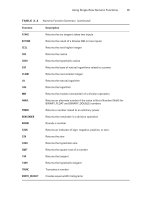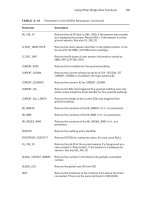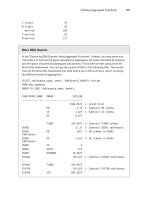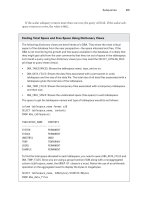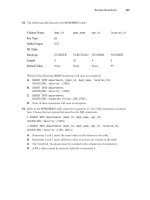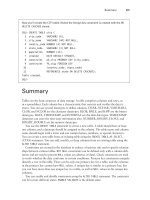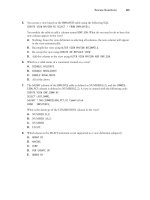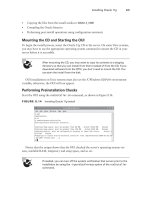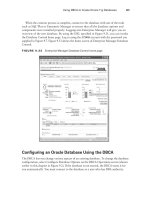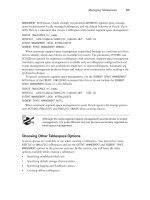Tài liệu OCA: Oracle Database 11g Administrator Certified Associate Study Guide- P22 docx
Bạn đang xem bản rút gọn của tài liệu. Xem và tải ngay bản đầy đủ của tài liệu tại đây (933.94 KB, 50 trang )
Using EM Support Workbench
981
Gathering Additional Diagnostic Information
On the Problem Details screen, under the Investigate and Resolve section, you have various
options. On the Self Service tab, you have links available to gather more information about
the problem. If you prefer self-service, you can run more checks on the database, diagnose
the current problem, or resolve the issue by running the SQL Repair Advisor (if the error is
caused by a SQL Statement). The following are your options on the Self Service tab:
Assess Damage
ÛN
Run Checkers: Run the database health check again to find more issues.
ÛN
Database Instance Health: Show the database health screen, which shows the num-
ÛN
ber of incidents and problems by hour for the last 24 hours.
Diagnose
ÛN
Alert Log: Shows the alert log entries related to the incident.
ÛN
Related Problems Across Topology: Shows any other incidents that may be related
ÛN
to the current problem.
Diagnostic Dumps for Last Incident: Shows the dump and trace files associated
ÛN
with the incident.
Go to Metalink and Research: Metalink is Oracle’s support site, where you can
ÛN
search and find solutions to the issue.
Resolve:
ÛN
SQL Repair Advisor: Since the problem is caused by a SQL statement, you can run
ÛN
the SQL Repair Advisor to fix the SQL issue.
You can use the tools under Diagnose to gather more information about the incident and
problem. If you have identified the SQL causing the problem and you find an issue with the SQL,
you can resolve the problem by yourself. You may also get an answer by searching Oracle’s
support website, Metalink. Contacting Metalink is discussed later in the chapter.
After self-service, if you could not resolve the problem or could not find more informa-
tion about the problem of symptoms, you can contact Oracle Support. EM Support Work-
bench makes contacting Oracle Support easy without having to remember the URL or
phone number and gathers all the information that would be of help to the support analyst.
Let’s go through the next steps of Support Workbench to contact Oracle Support for a reso-
lution to the example problem.
Creating a Service Request
If you cannot identify or resolve the issue yourself, the next logical step is to contact Oracle
Support for help. On the Problem Details page shown in Figure 17.13, click the Oracle Sup-
port tab under the Investigate and Resolve section. Figure 17.14 shows the Oracle Support tab.
95127c17.indd 981 2/17/09 3:10:41 PM
Please purchase PDF Split-Merge on www.verypdf.com to remove this watermark.
982
Chapter 17
N
Moving Data and Using EM Tools
FigUrE 17.14 Contacting the Oracle Support section of Support Workbench
The Create a Service Request with Metalink link takes you to the Metalink login page,
where you can log in and enter a service request. The URL for Metalink is
https://
metalink.oracle.com
. Once the service request (SR) is created, you can use the Edit button
on the Problem Details screen to update the SR number.
After you create the SR, the next step is to send relevant trace and dump files to Oracle
for analysis. Support Workbench provides a packaging service to make this task easier for
the DBA.
Oracle Support Services (OSS) is a 24/7 operation providing support to all Oracle cus-
tomers throughout the world. The primary method of contacting OSS is using the web page
at
. You have to register for an account first and provide
information such as the customer service identifier (CSI) number, your contact information,
so on.
Once you log in to Metalink, you can find a wealth of information, including the
following:
Searches for known issues
ÛN
Forum to discuss various issues
ÛN
Opening an SR
ÛN
Patches and updates
ÛN
Product certification
ÛN
Bug information
ÛN
Knowledge Base articles
ÛN
User documentation
ÛN
Electronic technical reference documents
ÛN
The Metalink forums enable you to interact with other customers to share ideas and
provide solutions. You can download patches and patch documentation.
95127c17.indd 982 2/17/09 3:10:41 PM
Please purchase PDF Split-Merge on www.verypdf.com to remove this watermark.
Using EM Support Workbench
983
See Metalink note 166650.1, “Global Customer Support Working Effectively
with Support,” for more information on using the Oracle Support Services.
Packaging Diagnostic Data
You can invoke packaging in two ways. On the Support Workbench page, you can select
the problem and click the Package button. This gives you the option to create a quick pack-
age or a custom package. A quick package gathers information for a single problem with
all the default options. With a custom package, you have the option to edit the package
contents, remove any sensitive data, and add more traces and test cases. Another option to
invoke packages is from the Problem Details screen, where you can invoke quick packaging
for the problem. You can also optionally upload the packaged information to Oracle under
the service request number. Figure 17.15 shows the Quick Packaging screen.
FigUrE 17.15 Quick Packaging screen
On this screen, you have the option to upload the created package to Oracle Support. If
you want Support Workbench to upload the information, provide your Metalink username
and password along with the CSI number. If you have not created an SR yet, you have the
option to create a new SR from this screen. Enter the SR number for uploading diagnostic
information for an existing SR.
95127c17.indd 983 2/17/09 3:10:42 PM
Please purchase PDF Split-Merge on www.verypdf.com to remove this watermark.
984
Chapter 17
N
Moving Data and Using EM Tools
If you choose custom packaging, the screen will look like Figure 17.16. Here Oracle will
show you all the incidents to report and the files that are being packaged. You can exclude
the files you do not want to send. Also, you have the option to add more incidents to the
same package.
FigUrE 17.16 Customize Package screen
In the Packaging Tasks section, you have the option to add more problems or exclude
problems. You can also edit the files you sent to Oracle. Once you have added all the neces-
sary files, click the Finish Contents Preparation link. You will see a confirmation screen with
all the files you choose to include in the packaging and an option to generate the upload file.
After the file is generated, the Send to Oracle button will be enabled, and you can use it to
send the information to Oracle.
Configuring Incident Packaging
You can customize the package-retention and -configuration rules by using the Incident
Packaging Configuration link in the Related Links section of the Support Workbench
screen. Figure 17.17 shows the default retention and packaging settings.
95127c17.indd 984 2/17/09 3:10:42 PM
Please purchase PDF Split-Merge on www.verypdf.com to remove this watermark.
Using EM Support Workbench
985
FigUrE 17.17 Incident packaging configuration
Click the Edit button to change the defaults. You can change the following values:
Incident Metadata Retention Period Information such as the incident ID, time, and prob-
lem are known as the metadata. The default is to keep this information for 365 days.
Incident Files Retention Period Specify how long you want to keep the files (data) related
to an incident; the default is 30 days.
Cutoff Age for Incident Inclusion Include the incidents that are not older than the value
specified here in days.
Leading Incidents Count and Trailing Incidents Count If a problem has several incidents,
the packaging by default includes only three incidents from the time it started occurring
and three incidents from the latest occurrence.
Correlation Time Proximity Specify the interval in minutes that should be treated as
“happened at the same time” for related incidents. The default is 90 minutes.
Time Window for Package Content This is the time in minutes to include incidents in the
package; the default is 24 minutes.
Tracking and Closing the Incident
You can track the progress of the incident by adding comments to the activity log. The activ-
ity log is available on the Problem Details screen as well as on the packaging screens. The
Activity Log tab shows the system-generated operations that have occurred on the problem
95127c17.indd 985 2/17/09 3:10:42 PM
Please purchase PDF Split-Merge on www.verypdf.com to remove this watermark.
986
Chapter 17
N
Moving Data and Using EM Tools
so far. This tab enables you to add your own comments while investigating the problem.
Figure 17.18 shows the Activity Log tab.
FigUrE 17.18 Problem activity log
You can add an entry using the Add Comment button. If the problem is related to an
Oracle bug, you can add the bug number on the Problem Details screen by clicking the Edit
button (shown earlier in Figure 17.13).
As you saw on the Self Service tab of the Problem Details screen, the Oracle advisors
that can help you repair critical errors are the SQL Repair Advisor and the Data Recovery
Advisor.
When you have a resolution for the issue, you can close the incident by clicking the Close
button on the Support Workbench screen or by clicking the Close the Problem link on the
Problem Details screen.
By default closed incidents are not shown on the Problem Details screen.
All incidents (open and closed) are purged after 30 days. You can disable
the incident purging on the Incident Details page. You can get to the Inci-
dent Details page by clicking the incident ID on the Problem Details screen
(shown earlier in Figure 17.13). Click the Disable Purging button to disable
the purging of the incident.
In the next section, you will learn how Enterprise Manager can help DBAs manage patches.
Using EM to Manage Patches
As a DBA, you have several reasons to download and apply patches. In Oracle 11g, Oracle
has made the patch research and application easier by integrating OSS with Enterprise
Manager. Oracle Corporation releases the following types of patches for its database
product:
Patch release A patch release is a major patch that changes the version number of the
database. Oracle release numbers have the format 11.1.0.6.0, where 11 is the major release
95127c17.indd 986 2/17/09 3:10:42 PM
Please purchase PDF Split-Merge on www.verypdf.com to remove this watermark.
Using EM to Manage Patches
987
number, 1 is the maintenance release number, 0 is the application-server release number,
6 is the component-specific release number, and 0 is the platform-specific release number.
When a patch release is applied, the component-specific release number will change. Patch
releases go through rigorous regression testing. Patch releases are cumulative, which means
the latest patch release will include most interim patches and critical patch updates, as well
as lower patch releases.
Interim patches Interim patches are one-off patches to fix a specific issue on a platform.
The Oracle release numbers do not change when applying interim patches. Interim patches
do not go through regression testing.
Critical patch updates Critical patch updates (CPUs) include security patches and other
patches that depend on the security patches. CPUs are cumulative, which means previ-
ous CPUs are included. CPUs go through regression testing, and they do not advance the
release numbers.
Patch releases are installed using the Oracle Universal Installer (OUI). You can install
interim patches and CPUs using the OPatch utility. You can use
opatch lsinventory to
review all the patches applied to an Oracle Home installation:
$ $ORACLE_HOME/OPatch/opatch lsinventory
Invoking OPatch 11.1.0.6.0
Oracle Interim Patch Installer version 11.1.0.6.0
Copyright (c) 2007, Oracle Corporation. All rights reserved.
Oracle Home : /u01/app/oracle/product/11.1.0/db_1
Central Inventory : /u01/app/oraInventory
from : /etc/oraInst.loc
OPatch version : 11.1.0.6.0
OUI version : 11.1.0.6.0
OUI location : /u01/app/oracle/product/11.1.0/db_1/oui
Log file location : /u01/app/oracle/product/11.1.0/db_1/
cfgtoollogs/opatch/opatch2008-11-16_23-08-22PM.log
Lsinventory Output file location :
/u01/app/oracle/product/11.1.0/db_1/cfgtoollogs/opatch/
lsinv/lsinventory2008-11-16_23-08-22PM.txt
Installed Top-level Products (1):
Oracle Database 11g 11.1.0.6.0
There are 1 products installed in this Oracle Home.
95127c17.indd 987 2/17/09 3:10:42 PM
Please purchase PDF Split-Merge on www.verypdf.com to remove this watermark.
988
Chapter 17
N
Moving Data and Using EM Tools
Interim patches (1) :
Patch 6529615 : applied on Sun Nov 16 23:08:05 CST 2008
Created on 7 Nov 2008, 04:01:26 hrs US/Pacific
Bugs fixed:
6529615
OPatch succeeded.
$
To apply a patch using OPatch, first read the README.txt file accompanying each patch
for instructions. Most of the patches are installed by using the
opatch apply statement,
from the patch staging directory. Enterprise Manager can be used to review, download, and
apply patches. The patch-management links are in the Database Software Patching section
on the Software and Support tab of Database Control, as shown in Figure 17.19.
FigUrE 17.19 Database Software Patching links on EM
I will discuss each link in the following sections.
Using the Patch Advisor
The Patch Advisor shows the critical patch updates and the recommended patches for the
release of the database on your server. Before you can use the Patch Advisor, you must set
up Metalink login credentials and perform Metalink integration with EM. You can do this
in two steps:
1. Enter the Metalink username and password. Click the Setup link on the top-right
corner of EM Database Control. Click Patching Setup on the left menu, as shown in
Figure 17.20.
2. Run the Refresh from Metalink job. Under the Related Links section on the Database
Control home page, click the Jobs link to invoke the Job Activity screen. Under the
Create drop-down list, choose Refresh from Metalink, and click Go, as shown in
Figure 17.21.
Click the Patch Advisor link on the screen shown in Figure 17.19. The Patch Advi-
sor screen shows critical security patches that need to be applied to
ORACLE_HOME and
95127c17.indd 988 2/17/09 3:10:42 PM
Please purchase PDF Split-Merge on www.verypdf.com to remove this watermark.
Using EM to Manage Patches
989
recommended patches, as shown in Figure 17.22. Oracle can show the recommended
patches based on the features used in the database. Select All from the drop-down box to
show all the recommended patches.
FigUrE 17.20 Software patching setup in EM
FigUrE 17.21 Refresh from Metalink job setup in EM
95127c17.indd 989 2/17/09 3:10:42 PM
Please purchase PDF Split-Merge on www.verypdf.com to remove this watermark.
990
Chapter 17
N
Moving Data and Using EM Tools
FigUrE 17.22 Patch Advisor screen on EM
You can also invoke the patching setup screen by clicking the Patching Setup link in the
Related Links section.
Viewing the Patch Cache
The patch cache is the location on the server where all your patches are downloaded and
kept. One advantage of having the patch cache is that you can apply the patch to multiple
Oracle Homes from one download. Figure 17.23 shows the Patch Cache screen.
FigUrE 17.23 Patch Cache screen in EM
You can click the View ReadMe button to read the patch application details, and you
can click the Patch button to apply the patch.
95127c17.indd 990 2/17/09 3:10:42 PM
Please purchase PDF Split-Merge on www.verypdf.com to remove this watermark.
Using EM to Manage Patches
991
Finding the Patch Prerequisites
Click the Patch Prerequisite Check link to get the screen to evaluate the standard prerequisite
checks on Oracle Home and Server with deployment-specific checks. Figure 17.24 shows the
Patch prerequisite checker screen.
FigUrE 17.24 Patch Prerequisite Checker screen in EM
Staging a Patch
You can download patches from Metalink and stage them for later application. Figure 17.25
shows the staging patch screen.
You can select the patch to download by specifying the patch number or by specifying
the product and release-number criteria. When the patches are displayed, choose the patch
you want to stage. Click Next to prepare for staging or applying the patch.
On the next screen, specify the targets or destination of the patch. You can choose the
Oracle Instance name or the Oracle home location. On the Set Credentials screen, specify
the host operating-system username and password. On the Stage or Apply screen, you can
choose to download the patch or to apply the patch after downloading. On the Schedule
screen, specify whether you want the patch to be downloaded immediately or at a later time.
Figure 17.26 shows the Summary screen. Review the patch sizes, where the patches will be
applied, and so on, and click the Finish button to download the patch.
95127c17.indd 991 2/17/09 3:10:42 PM
Please purchase PDF Split-Merge on www.verypdf.com to remove this watermark.
992
Chapter 17
N
Moving Data and Using EM Tools
FigUrE 17.25 Staging patch screen in EM
FigUrE 17.26 Patch: Summary screen in EM
Staged patches are stored under the $ORACLE_HOME/EMStagedPatches directory in
this example.
95127c17.indd 992 2/17/09 3:10:43 PM
Please purchase PDF Split-Merge on www.verypdf.com to remove this watermark.
Using EM to Manage Patches
993
Applying a Patch
When you click the Apply Patch link on the Software and Support page, you invoke the
Patch Wizard. Figure 17.27 shows the first screen, where the wizard prompts you to select
the patches.
FigUrE 17.27 Apply Patch Wizard in EM
Click the Add Patches button to select the patches to apply. The Add Patches button
brings you to the page shown in Figure 17.28, where you can search for patches and select
the patch.
The Target List step is skipped for non-RAC instances; the Library Step Properties step
is also skipped most of the time, unless you have customized the deployment procedures.
The Credentials and Schedule screen prompts you to enter the Oracle software-owner user-
name and password. For the schedule, you can specify one time (immediately), one time
(later), or repeating.
95127c17.indd 993 2/17/09 3:10:43 PM
Please purchase PDF Split-Merge on www.verypdf.com to remove this watermark.
994
Chapter 17
N
Moving Data and Using EM Tools
FigUrE 17.28 Searching for and selecting patches in EM
Figure 17.29 shows the review screen. The patch will be downloaded and applied when
you click the Finish button.
FigUrE 17.29 Apply patch Summary screen in EM
As you can see from the previous screens and options, EM Database Control helps DBAs
be proactive about the critical and recommended patches they need.
95127c17.indd 994 2/17/09 3:10:43 PM
Please purchase PDF Split-Merge on www.verypdf.com to remove this watermark.
Exam Essentials
995
Summary
In this chapter, I discussed how to move data using Oracle Data Pump, using SQL*Loader,
and using external tables. You also learned how to use Enterprise Manger to diagnose and
contact Oracle Support as well as manage patches.
Data Pump is a very high-speed infrastructure for data and metadata movement. The
client utilities
expdp and impdp are used to unload and load data and metadata. The Data
Pump architecture includes the data and metadata movement engine
DBMS_DATAPUMP, the
Direct Path API that supports a stream interface, the metadata API
DBMS_METADATA, the
external tables API, and the client utilities.
Data Pump export and import are performed on the server. You can attach to a job from
any computer and monitor its progress or make resource adjustments. In the interactive
mode, you can add a file to export a dump-file set, kill a job, stop a job, change the paral-
lelism, and enable detailed status logging.
SQL*Loader is used to load ASCII files to the Oracle database. You can invoke Data Pump
and SQL*Loader using EM Database Control.
You can also use external tables to move data. You can use the
ORACLE_DATAPUMP access
driver to write data into an external table, and you can use the
ORACLE_LOADER access driver
to read flat files into Oracle Database.
EM Database Control infrastructure enhancements include Support Workbench and
patch management. Using Support Workbench, you can identify, investigate, diagnose, and
resolve incidents. The Patch Advisor provides the patches that are needed on the database
and can be used to stage and apply patches.
Exam Essentials
Know how to create database directory objects. Directory objects are required for use in
the Data Pump export and Data Pump import programs.
Know that directory objects are not owned by individual schema. Directory objects are
not schema objects. Instead, they are owned by the database like roles or profiles.
Be aware of the Data Pump export and import modes. Data Pump export has database,
schema, table, and tablespace modes, and Data Pump import has full, schema, table, and
tablespace modes. Although these modes sound similar, they differ between the two tools.
Be familiar with the Data Pump options that let you transfer both data and metadata from
one schema to another. T h e
content= parameter controls whether data, metadata, or
both are copied. The
remap_schema parameter allows you to transfer data from one schema
to another.
95127c17.indd 995 2/17/09 3:10:43 PM
Please purchase PDF Split-Merge on www.verypdf.com to remove this watermark.
996
Chapter 17
N
Moving Data and Using EM Tools
Be aware of the limitations of SQL*Loader direct-path mode, including unusable indexes.
SQL*Loader direct-path mode has several limitations, the most prominent being that it
locks the table in exclusive mode for the duration of the load. Unique indexes are marked
unusable if unique violations are found after a direct path load. These unique violations
must be resolved before the index can be rebuilt.
Know the external table access drivers.
ORACLE_DATAPUMP and ORACLE_LOADER are the
access drivers used with external tables. The
ORACLE_DATAPUMP access driver can be used to
read and write to an external table. The
ORACLE_LOADER access driver is read-only.
Understand Support Workbench’s capabilities. Support Workbench can identify, diagnose,
and package an incident to contact Oracle Support Services for help.
Be familiar with the Patch Advisor and patch staging screens. EM Database Control
makes patch management easy. You can get information about the patches relevant to the
database, you can stage patches, and you can apply patches.
95127c17.indd 996 2/17/09 3:10:43 PM
Please purchase PDF Split-Merge on www.verypdf.com to remove this watermark.
Review Questions
997
Review Questions
1. Which two PL/SQL packages are used by Oracle Data Pump?
A. UTL_DATAPUMP
B. DBMS_METADATA
C. DBMS_DATAPUMP
D. UTL_FILE
E. DBMS_SQL
2. These options list the benefits of Oracle Data Pump; pick two that are not true.
A. Data Pump supports fine-grained object selection using the EXCLUDE, INCLUDE, and
CONTENT options.
B. Data Pump has the ability to specify the target version of the database so that the
objects exported are compatible. This is useful in moving data from Oracle 10g to
Oracle9i.
C. Data Pump has the ability to specify the maximum number of threads to unload data.
D. The DBA can choose to perform the export using direct path or external tables.
E. The Data Pump job can be monitored from another computer on the network.
3. The Data Pump job maintains a master control table with information about Data Pump.
Choose the right statement.
A. The master table is the heart of Data Pump operation and is maintained in the SYS
schema.
B. The master table contains one row for the operation that keeps track of the object
being worked so that the job can be restarted in the event of failure.
C. During the export, the master table is written to the dump file set at the beginning of
export operation.
D. The Data Pump job runs in the schema of the job creator with that user’s rights and
privileges.
E. All of the above.
4. When using the expdp and impdp clients, the parameters LOGFILE, DUMPFILE, and SQLFILE
need a directory object where the files will be written to or read from. Choose the non-
supported method for non-privileged users.
A. Specify the DIRECTORY parameter.
B. Specify the filename parameters with directory:file_name.
C. Use the initialization parameter DATA_PUMP_DIR.
D. None of the above (all are supported).
95127c17.indd 997 2/17/09 3:10:43 PM
Please purchase PDF Split-Merge on www.verypdf.com to remove this watermark.
998
Chapter 17
N
Moving Data and Using EM Tools
5. Which command-line parameter of expdp and impdp clients connects you to an existing job?
A. CONNECT_CLIENT
B. CONTINUE_CLIENT
C. APPEND
D. ATTACH
6. Which option unloads the data and metadata of the SCOTT user, except the tables that begin
with TEMP? The dump file also should have the DDL to create the user.
A. CONTENT=BOTH TABLES=(not like ‘TEMP%’) SCHEMAS=SCOTT
B. SCHEMAS=SCOTT EXCLUDE=TABLE:”LIKE ‘TEMP%’”
C. INCLUDE=METADATA EXCLUDE=TABLES:”NOT LIKE ‘TEMP%’” SCHEMAS=SCOTT
D. TABLES=”NOT LIKE ‘TEMP%’” SCHEMAS=SCOTT
7. Which parameter is not a valid one for using the impdp client?
A. REMAP_INDEX
B. REMAP_TABLE
C. REMAP_SCHEMA
D. REMAP_TABLESPACE
E. REMAP_DATAFILE
8. When do you use the FLASHBACK_TIME parameter in the impdp utility?
A. To load data from the dump file that was modified after a certain time.
B. To discard data from the dump file that was modified after a certain time.
C. When the NETWORK_LINK parameter is used.
D. FLASHBACK_TIME is valid only with expdp, not with impdp.
9. To perform a Data Pump import from a live database, which parameter needs to be set?
A. db_link
B. network_link
C. dumpfile
D. directory
10. Choose two statements about EM Support Workbench that are true.
A. It can identify problems, contact Oracle Support, and resolve problems automatically.
B. It helps collect diagnostic data and package it to send to Oracle Support.
C. Multiple incidents of similar nature are combined as a problem.
D. It is primarily used to track service requests created with Oracle Support.
95127c17.indd 998 2/17/09 3:10:43 PM
Please purchase PDF Split-Merge on www.verypdf.com to remove this watermark.
Review Questions
999
11. Which types of patches do not undergo rigorous testing?
A. Interim patches
B. Critical patch updates
C. Patch releases
D. None of the above
12. When is it most appropriate to use external table?
A. When you need to read binary files (PDF and photos) into Oracle Database
B. To query a large file without loading the data into the database
C. When the expdp and impdp utilities are not licensed for use
D. To load a large file into the database quickly
13. Which constraint is not enforced during the direct path load using SQL*Loader?
A. Primary key.
B. Unique key.
C. Not null.
D. Check.
E. All the constraints are enforced.
F. No constraints are enforced.
14. Which utility can be used to identify the patches applied to your Oracle Database home
location?
A. ADRCI
B. OPatch
C. Oracle Universal Installer (OUI)
D. All of the above
15. Choose the correct statement about Oracle Support Services.
A. Support can be contacted using the metalink.oracle.com web page.
B. Anyone can register and search Oracle Support’s Knowledge Base.
C. There is no published phone number to contact OSS.
D. Support analysts are available only during U.S. Pacific time zone work hours.
16. When using EM Database Control to load data into Oracle Database from a flat file, you
should do which of the following?
A. Cut and paste the file content into the data text box.
B. Always build your own control file and specify it for the data load.
C. Keep the log file, bad file, and data file in the same directory.
D. Load the data file from the server or on your client machine.
E. Load the data from the client machine.
95127c17.indd 999 2/17/09 3:10:43 PM
Please purchase PDF Split-Merge on www.verypdf.com to remove this watermark.
1000
Chapter 17
N
Moving Data and Using EM Tools
17. Choose the statement that is not true from the following about direct path load.
A. Direct path load cannot occur if active transactions against the table are being loaded.
B. Triggers do not fire during direct path loads.
C. During direct path loads, foreign key constraints are disabled at the beginning of the
load and then reenabled after the load.
D. Only primary key, unique, and NOT NULL constraints are enforced.
E. Direct path load allows other users to perform DML operations on the table while the
direct load operation is in progress.
18. Which two advisors can help you repair critical errors?
A. SQL Tuning Advisor
B. SQL Repair Advisor
C. SQL Syntax Advisor
D. Data Recovery Advisor
19. When using EM Support Workbench, how is a problem closed?
A. When the error is no longer appearing
B. When Oracle Support Services closes the SR in Metalink
C. When the DBA manually closes the incident
D. All of the above
20. To register for Oracle Support Services Metalink access, you must do which of the following?
(Choose all that apply.)
A. Have a valid driver’s license
B. Be an Oracle customer with a valid CSI number
C. Get approval from the CSI administrator
D. Be a member of the IOUG or OAUG user group
95127c17.indd 1000 2/17/09 3:10:43 PM
Please purchase PDF Split-Merge on www.verypdf.com to remove this watermark.
Answers to Review Questions
1001
Answers to Review Questions
1. B, C. The DBMS_METADATA package provides the database object definitions to the export
worker process in the proper order of their creation. The DBMS_DATAPUMP package has the
API for high-speed export and import for bulk data and metadata loading and unloading.
2. B, D. Oracle Data Pump is known to versions 10g and newer; Oracle9i does not support
Data Pump. Though Data Pump can perform data access using the direct-path or external-
table method, Data Pump makes the decision automatically; the DBA cannot specify the
data-access method. Data Pump also supports network mode to import directly from the
source database and can estimate the space requirements for the dump file.
3. D. The master table is the heart of the Data Pump operation and is maintained in the
schema of the job creator. It bears the name of the job, contains one row for each object
and each operation, and keeps status. Using this information helps restart a failed job or
suspend and resume a job. The master table is written to the dump file as the last step of the
export and is loaded to the schema of the user as the first step of the import.
4. C. If a directory object is created with name DATA_PUMP_DIR, the privileged users can use
this location as the default location for Data Pump files. Privileged users are users with
EXP_FULL_DATABASE or IMP_FULL_DATABASE roles. Using %U in the filename generates mul-
tiple files for parallel unloads with each parallel process writing to one file.
5. D. The ATTACH parameter lets you attach or connect to an existing Data Pump job and
places you in interactive mode. ATTACH without any parameters attaches to the currently
running job, if there is only one job from the user. Otherwise, you must specify the job
name when using the ATTACH parameter.
6. B. If the CONTENT parameter is not specified, both data and metadata will be unloaded. The
valid values for CONTENT are METADATA_ONLY, DATA_ONLY, and ALL. If Scott is performing
the export, SCHEMAS=SCOTT is optional.
7. A. REMAP_DATAFILE changes the name of the source data file to the target data filename in
all DDL statements where the source data file is referenced. REMAP_SCHEMA loads all objects
from the source schema into the destination schema. When using REMAP_TABLESPACE, all
objects selected for import with persistent data in the source tablespace are remapped to be
created in the destination tablespace. REMAP_TABLE changes the name of the table. Since the
dump file is in XML format, Data Pump can make these transformations easily. REMAP_INDEX
is an invalid parameter.
8. C. You can specify the FLASHBACK_TIME or FLASHBACK_SCN parameter only when perform-
ing a network import where the source is a database.
9. B. The network_link parameter specifies a database link to the source database.
10. B, C. Oracle Support Workbench can help DBAs diagnose the problem, collect more informa-
tion and related traces, and dump files into a package to send to Oracle Support for analysis.
95127c17.indd 1001 2/17/09 3:10:43 PM
Please purchase PDF Split-Merge on www.verypdf.com to remove this watermark.
1002
Chapter 17
N
Moving Data and Using EM Tools
11. A. Interim patches are also known as one-off patches, created for a specific problem. CPU
and patch releases undergo rigorous testing.
12. B. External tables can be used to read ASCII flat files without loading into the database.
The external table must be created with the ORACLE_LOADER access driver.
13. D. Primary key, unique key, and not null constraints are enforced during direct path load.
Check and foreign key constraints are not enforced.
14. B. OPatch is used to apply the CPU and interim patches. The lsinventory option of the
$ORACLE_HOME/OPatch/opatch command is used to query patches.
15. A. OSS can be contacted via phone or the Web. The Web is the preferred method of contact.
16. D. The data file, log file, and bad file can be on the database server or on the client machine.
When using a database server, you must specify the file location using directory objects.
17. E. While the direct path load is in progress, users cannot run any DML statements against
the table. Only queries are allowed.
18. B, D. The SQL Repair Advisor can be invoked to diagnose issues arising out of SQL state-
ments. The Data Recovery Advisor can be used to recover from block corruptions and miss-
ing data files.
19. C. Problems are closed manually by the DBA. If the retention periods are not changed,
incident data will be purged from the Automatic Diagnostic Repository after 30 days, and
Metadata will be kept for 1 year.
20. B, C. You must have a valid customer support identifier to register and use the OSS web page.
95127c17.indd 1002 2/17/09 3:10:43 PM
Please purchase PDF Split-Merge on www.verypdf.com to remove this watermark.
Appendix
About the
Companion CD
IN THIS APPENDIX:
What you’ll find on the CD
System requirements
Using the CD
Troubleshooting
95127bapp.indd 1003 2/17/09 3:12:26 PM
Please purchase PDF Split-Merge on www.verypdf.com to remove this watermark.
What You’ll Find on the CD
The following sections are arranged by category and summarize the software and other
goodies you’ll find on the CD. If you need help with installing the items provided on the
CD, refer to the installation instructions in the “Using the CD” section of this appendix.
Some programs on the CD might fall into one of these categories:
Shareware programs are fully functional, free, trial versions of copyrighted programs.
If you like particular programs, register with their authors for a nominal fee and
receive licenses, enhanced versions, and technical support.
Freeware programs are free, copyrighted games, applications, and utilities. You can
copy them to as many computers as you like—for free—but they offer no technical
support.
GNU software is governed by its own license, which is included inside the folder of
the GNU software. There are no restrictions on distribution of GNU software. See the
GNU license at the root of the CD for more details.
Trial, demo, or evaluation versions of software are usually limited either by time or by
functionality (such as not letting you save a project after you create it).
Sybex Test Engine
For Windows
The CD contains the Sybex test engine, which includes all the assessment test and chap-
ter review questions in electronic format, as well as two bonus exams located only on the CD.
PDF of the Book
For Windows
We have included an electronic version of the text in
.pdf format. You can view the elec-
tronic version of the book with Adobe Reader.
95127bapp.indd 1004 2/17/09 3:12:26 PM
Please purchase PDF Split-Merge on www.verypdf.com to remove this watermark.
Using the CD
1005
Adobe Reader
For Windows
We’ve also included a copy of Adobe Reader so you can view PDF files that accompany
the book’s content. For more information on Adobe Reader or to check for a newer version,
visit Adobe’s website at
www.adobe.com/products/reader/.
Electronic Flashcards
For PC, Pocket PC, and Palm
These handy electronic flashcards are just what they sound like. One side contains a
question or fill-in-the-blank question, and the other side shows the answer.
System Requirements
Make sure your computer meets the minimum system requirements shown in the following
list. If your computer doesn’t match up to most of these requirements, you may have prob-
lems using the software and files on the companion CD. For the latest and greatest infor-
mation, please refer to the ReadMe file located at the root of the CD-ROM.
A PC running Microsoft Windows 98, Windows 2000, Windows NT4 (with SP4 or
later), Windows Me, Windows XP, or Windows Vista
An Internet connection
A CD-ROM drive
Using the CD
To install the items from the CD to your hard drive, follow these steps:
1. Insert the CD into your computer’s CD-ROM drive. The license agreement appears.
2. Read the license agreement, and then click the Accept button if you want to use the CD.
The CD interface appears. The interface allows you to access the content with just one
or two clicks.
95127bapp.indd 1005 2/17/09 3:12:26 PM
Please purchase PDF Split-Merge on www.verypdf.com to remove this watermark.
